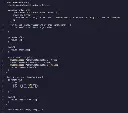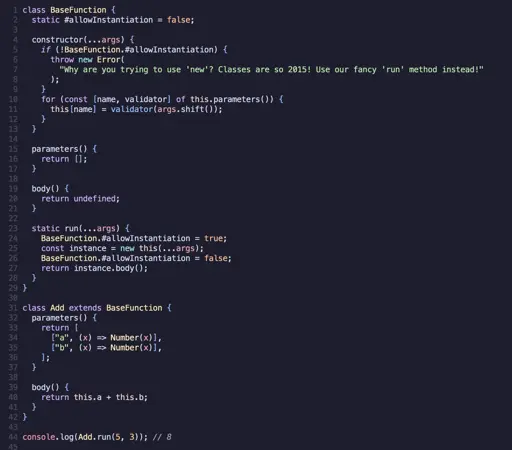Real Programmers Implement Functions On Top Of Classes
Real Programmers Implement Functions On Top Of Classes


class BaseFunction {
static #allowInstantiation = false;
constructor(...args) {
if (!BaseFunction.#allowInstantiation) {
throw new Error(
"Why are you trying to use 'new'? Classes are so 2015! Use our fancy 'run' method instead!"
);
}
for (const [name, validator] of this.parameters()) {
this[name] = validator(args.shift());
}
}
parameters() {
return [];
}
body() {
return undefined;
}
static run(...args) {
BaseFunction.#allowInstantiation = true;
const instance = new this(...args);
BaseFunction.#allowInstantiation = false;
return instance.body();
}
}
class Add extends BaseFunction {
parameters() {
return [
["a", (x) => Number(x)],
["b", (x) => Number(x)],
];
}
body() {
return this.a + this.b;
}
}
console.log(Add.run(5, 3)); // 8
That'll be fun in a multi threaded setting!
3 0 ReplyI've seen something similar to this at work. Horrible.
2 0 ReplyWhat theme are you using, i like it!
3 0 ReplyLooks like Catppuccin Mocha
4 0 ReplyActually now that check it again its not quite right for mocha. But it's close!
2 0 ReplyThanks!
2 0 Reply
Very DRY.
2 0 ReplyOP, what's your address? I have a "present" for you
37 0 ReplyA true FP programmer would make it
applyinstead ofrun...30 0 ReplyAhem, map...
And, of course, everything is a lazy list even if the functions can't handle more than one element in each list.
12 2 Reply
It's just Java
20 2 ReplyYep, some code examples from the official documentation. This:
printPersons( roster, (Person p) -> p.getGender() == Person.Sex.MALE && p.getAge() >= 18 && p.getAge() <= 25 );...is syntactic sugar for this:
interface CheckPerson { boolean test(Person p); } printPersons( roster, new CheckPerson() { public boolean test(Person p) { return p.getGender() == Person.Sex.MALE && p.getAge() >= 18 && p.getAge() <= 25; } } );...which is syntactic sugar for this:
interface CheckPerson { boolean test(Person p); } class CheckPersonEligibleForSelectiveService implements CheckPerson { public boolean test(Person p) { return p.gender == Person.Sex.MALE && p.getAge() >= 18 && p.getAge() <= 25; } } printPersons(roster, new CheckPersonEligibleForSelectiveService());The
printPersonsfunction looks like this:public static void printPersons(List<Person> roster, CheckPerson tester) { for (Person p : roster) { if (tester.test(p)) { p.printPerson(); } } }Basically, if you accept a parameter that implements an interface with only one method (
CheckPerson), then your caller can provide you an object like that by using the lambda syntax from the first example.They had to retrofit lambdas into the language, and they sure chose the one hammer that the language has.
Source: https://docs.oracle.com/javase/tutorial/java/javaOO/lambdaexpressions.html
21 1 ReplyThat's not quite right. In bytecode, lambdas are significantly more efficient than anonymous class instances. So while the lambda implementation is semantically equivalent, characterizing it like you have is reductive and a bit misleading.
14 0 Reply
Hence, Clojure. It's not just functions that implement IFn... as the string of "cannot cast to clojure.lang.IFn" errors that I get because I couldn't be bothered to validate my data's shape is eager to inform me.
4 0 ReplyGolang also does this, but it's not classes.
3 0 ReplyHow so?
1 0 Reply
validatorsis a shitty name for something that actually does type conversion.17 0 ReplyDont look at C++ with std:: function
12 0 ReplyJS disgusts me
11 0 ReplyAmazing, lol
4 0 ReplyI think that's called a functor.
4 1 Reply